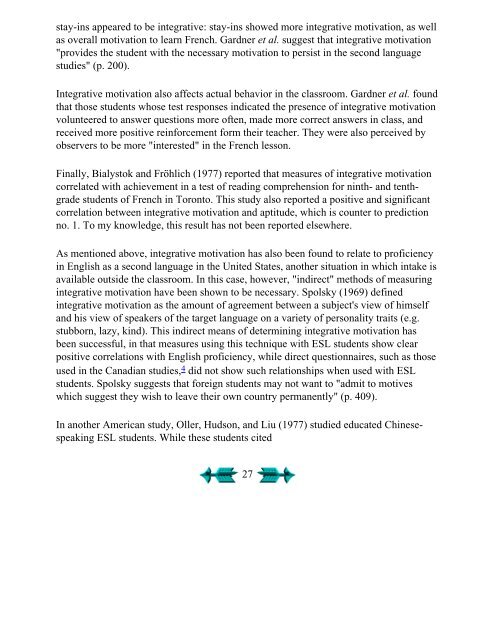Second Language Acquisition and Second ... - Stephen Krashen
Second Language Acquisition and Second ... - Stephen Krashen
Second Language Acquisition and Second ... - Stephen Krashen
Create successful ePaper yourself
Turn your PDF publications into a flip-book with our unique Google optimized e-Paper software.
stay-ins appeared to be integrative: stay-ins showed more integrative motivation, as well<br />
as overall motivation to learn French. Gardner et al. suggest that integrative motivation<br />
"provides the student with the necessary motivation to persist in the second language<br />
studies" (p. 200).<br />
Integrative motivation also affects actual behavior in the classroom. Gardner et al. found<br />
that those students whose test responses indicated the presence of integrative motivation<br />
volunteered to answer questions more often, made more correct answers in class, <strong>and</strong><br />
received more positive reinforcement form their teacher. They were also perceived by<br />
observers to be more "interested" in the French lesson.<br />
Finally, Bialystok <strong>and</strong> Fröhlich (1977) reported that measures of integrative motivation<br />
correlated with achievement in a test of reading comprehension for ninth- <strong>and</strong> tenthgrade<br />
students of French in Toronto. This study also reported a positive <strong>and</strong> significant<br />
correlation between integrative motivation <strong>and</strong> aptitude, which is counter to prediction<br />
no. 1. To my knowledge, this result has not been reported elsewhere.<br />
As mentioned above, integrative motivation has also been found to relate to proficiency<br />
in English as a second language in the United States, another situation in which intake is<br />
available outside the classroom. In this case, however, "indirect" methods of measuring<br />
integrative motivation have been shown to be necessary. Spolsky (1969) defined<br />
integrative motivation as the amount of agreement between a subject's view of himself<br />
<strong>and</strong> his view of speakers of the target language on a variety of personality traits (e.g.<br />
stubborn, lazy, kind). This indirect means of determining integrative motivation has<br />
been successful, in that measures using this technique with ESL students show clear<br />
positive correlations with English proficiency, while direct questionnaires, such as those<br />
used in the Canadian studies, 4 did not show such relationships when used with ESL<br />
students. Spolsky suggests that foreign students may not want to "admit to motives<br />
which suggest they wish to leave their own country permanently" (p. 409).<br />
In another American study, Oller, Hudson, <strong>and</strong> Liu (1977) studied educated Chinesespeaking<br />
ESL students. While these students cited<br />
27











